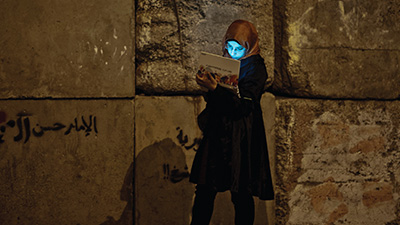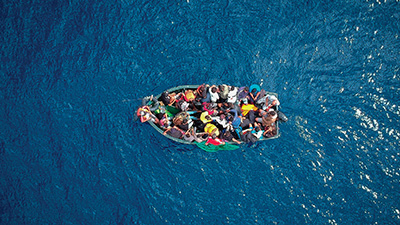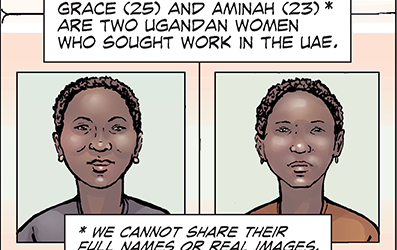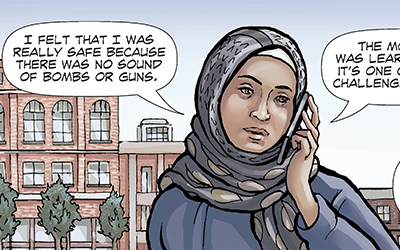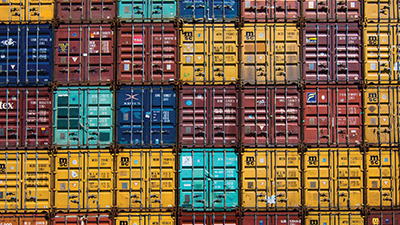Globalized Culture After 1900
Driving Question: To what extent has culture transcended national borders, and what are the consequences of this shift?
From music to movies to sporting events, globalization fosters a global culture. Trends and news are shared instantly, meaning that arts, entertainment, and popular culture increasingly reflect a shared, globalized society. But is this always a good thing?
Learning Objectives
- Explain how and why globalization changes culture over time.
- Use close reading skills to analyze the effects of globalization on various cultures around the world.
Vocab Terms:
- automation
- climate change
- globalization
- inequality
- multinational
- regulation
Opener: Globalized Culture After 1900
To teach this lesson step, refer to page 3 of the Lesson 9.6 Teaching Guide.
Thanks to globalization, people share culture even though they live thousands of miles apart. Is this a good thing or a bad thing?
Our Networks Today
To teach this lesson step, refer to page 3 of the Lesson 9.6 Teaching Guide.
Social media is everywhere, but has it helped bring people together? Or has it isolated us further?
-
Guiding Questions
-
Before you read
Preview the questions below, and then skim the article. Be sure to look at the section headings and any images.
While you read
Look for answers to these questions:
- How have networks of knowledge changed since 1969?
- What are some ways that social media connects people?
- How has social media helped people to organize?
- What are some elements of the “dark side” of social media?
After you read
Respond to the following questions:
- In your personal experience, has social media and the internet made you feel more of a “global citizen” and connected to other people, more connected to your family and local community, or more isolated overall?
- How has the size and scale of networks changed over time? In a few sentences, describe the long history of changes in human networks.
A Century of Refugees
To teach this lesson step, refer to page 4 of the Lesson 9.6 Teaching Guide.
The number of migrants has grown substantially in recent years. What role has globalization played in this growth?
-
Guiding Questions
-
Before you read
Preview the questions below, and then skim the article. Be sure to look at the section headings and any images.
While you read
Look for answers to these questions:
- Why did anti-migrant protests happen in Europe after 2015?
- What country hosts the most refugees, and what did they receive for limiting illegal refugee migration into the European Union?
- How did nationalism shape governments’ approaches to dealing with refugees and migration in general?
- How did decolonization lead to an increase in refugees?
- What are some reasons that refugees migrate and seek refuge?
- Why do some nations, in particular wealthy nations, allow migrant workers to come into their countries?
- How did wealthy nations react to increasing refugee and labor migration?
After you read
Respond to the following question: How do you think globalization has changed the ways that people have migrated in the last 100 years?
Graphic Biography: Ugandan Migrants
To teach this lesson step, refer to page 6 of the Lesson 9.6 Teaching Guide.
Explore the very different experiences of two Ugandan women who traveled abroad to find work. This graphic biography presents yet another way in which globalization has varied impacts.
-
Guiding Questions
-
Before you read
Preview the questions below, and then skim the comic, paying attention to things like prominent colors, shapes, and types of text and fonts. How do you know where to start and in which direction to read? What’s in the gutters (the space between panels)? Who or what is the focus of the comic?
While you read
Look for answers to these questions:
- Where did Grace and Aminah come from, and why were they seeking work in the United Arab Emirates?
- How did Grace and Aminah get permits to travel?
- How were Grace and Aminah’s experiences in the UAE different?
- How did the Ugandan government react to the experiences of its citizens like Aminah?
- How did the artist use art and design to show the different experiences of Grace and Aminah?
After you read
Respond to the following question: How does this biography of Ugandan migrants to the UAE support, extend, or challenge what you have learned about how different communities have experienced globalization in the contemporary era?
Graphic Biography: Islam Alhashel
To teach this lesson step, refer to page 7 of the Lesson 9.6 Teaching Guide.
Islam Alhashel, like many refugees, was forced to flee her country because of persecution, war, or violence. Her story can help us understand the effect of globalization on various communities.
-
Guiding Questions
-
Before you read
Preview the questions below, and then skim the comic, paying attention to things like prominent colors, shapes, and types of text and fonts. How do you know where to start and in which direction to read? What’s in the gutters (the space between panels)? Who or what is the focus of the comic?
While you read
Look for answers to these questions:
- Where was Islam Alhashel born and why did her family leave?
- Where did her family first find refuge, and how did they move onward?
- What were Islam’s experiences when they arrived in the United States?
- How does the artist use art and design to depict how Islam’s life was fractured, and then rebuilt?
After you read
Respond to the following question: How does this biography of Islam Alhashel support, extend, or challenge what you have learned about how different communities have experienced globalization in the contemporary era?
Goods Across the World
To teach this lesson step, refer to page 8 of the Lesson 9.6 Teaching Guide.
Explore how iPhones and Starbucks coffee illustrate our vast global networks, but also the challenges created by these networks—including the controversies and criticisms that have been directed at the massive corporations that produce these products, and their global footprints.
-
Guiding Questions
-
Before you read
Preview the questions below, and then skim the article. Be sure to look at the section headings and any images.
While you read
Look for answers to these questions:
- How do cheap labor and unregulated workplaces influence global trade?
- How has the American economy changed in recent years as manufacturing jobs have been lost to automation or have moved to countries with lower labor costs?
- Besides the extremely high costs that would probably be required to manufacture iPhones in the United States, Apple CEO Tim Cook also notes the lack of skilled workers in the United States as a reason for moving manufacturing to China. Why does this lack exist?
- What are “conflict minerals” and what are some examples of them?
- Why is it difficult to know what products have achieved certification and met ethical standards, such as being “ethically sourced” or “Fairtrade”?
- What kind of complaints against Starbucks are mentioned in this essay, and what are some examples of the company’s responses?
After you read
Respond to the following prompt: Use evidence from this article to explain how and why globalization changed labor and culture over time.
Closer: Globalized Culture After 1900
To teach this lesson step, refer to page 9 of the Lesson 9.6 Teaching Guide.
It can be tricky to follow something around the world without a map. Check out OER Project’s collection of Maps.
Think about the clothes you’re wearing, or the phone in your hand. They probably came from pretty far away. Let’s follow the product to find out.


